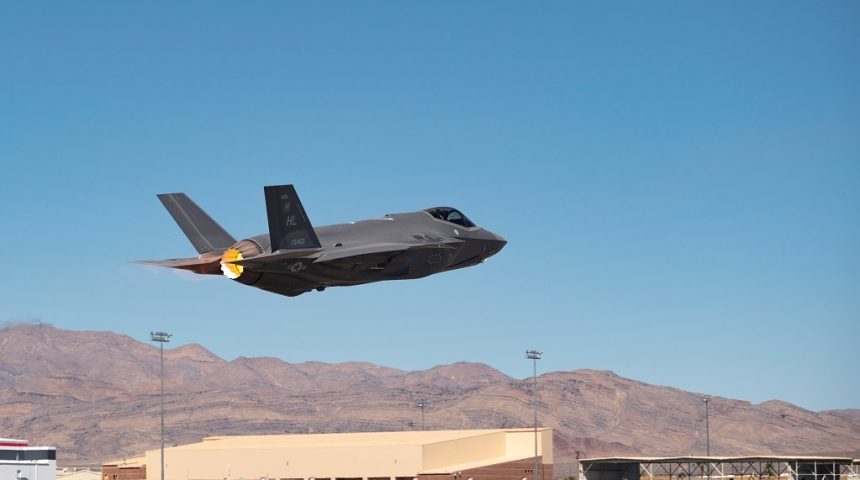The Lightning II gets one step closer to become the next Air Force aircraft, and first 5th Generation platform, to achieve compatibility with the refurbished B61-12 nuclear gravity bomb.
The F-35 Joint Program Office (JPO) announced on October 4, 2021, the completion of an important milestone for the F-35A Lightning II, which is now one step closer to becoming the next U.S. Air Force aircraft, and the first 5th Generation platform, to achieve compatibility with the refurbished B61-12 nuclear gravity bomb. This milestone saw the F-35 performing the first Full Weapon System Demonstration, considered the “graduation” flight test exercise for achieving nuclear design certification from an air-delivered platform.
The demonstration involved two F-35s assigned to Hill Air Force Base, Utah, according to the photos released with the announcement, but flown by pilots from the 422nd Test and Evaluation Squadron, part of the 53rd Test and Evaluation Group. After taking off from Nellis AFB, Nevada, the two aircraft flew for 160 miles and conducted two separate drops of high-fidelity, non-nuclear mock B61-12 Joint Test Assemblies (JTAs) at Sandia National Laboratories’ Tonopah Test Range.
The jets released the inert weapons at varying altitudes and airspeeds, clearing the desired operationally realistic flight envelopes in which the F-35A plans to operate. The flights marked the last of 10 guided releases of B61-12 test assets from the F-35A as well as the first release of the most representative B61-12 test asset from an operationally-representative F-35A (that might explain why Hill AFB’s jets were used instead of the 422nd TES own ones).
“The B61 series weapons are tactical gravity nuclear weapons that can be used on Dual Capable Aircraft like the F-15E and F-16C/D,” said Lt. Col Daniel Jackson, division chief, Headquarters ACC Strategic Deterrence and Nuclear Integration. “Having a 5th Generation DCA fighter aircraft with this capability brings an entirely new strategic-level capability that strengthens our nation’s nuclear deterrence mission.”
While the Lightning II is not yet fully certified to conduct real world nuclear operations, the successful completion of this Full Weapon System Demonstration concludes on-aircraft testing for F-35A’s initial nuclear certification effort. The nuclear certification is broken into two phases: nuclear design certification and nuclear operational certification. As already mentioned, this test concluded the first phase.

This demonstration was the culmination of years of planning and lead-up flight test activities and involved numerous organizations across the Department of Defense (DoD) and Department of Energy (DoE), which are now performing the technical analysis of the data collected during the test, with the goal of ensuring that all test requirements were met and that the B61-12 performs reliably and safely on the F-35A in all phases of operation.
“The B-2 bomber was the prominent nuclear capable stealth aircraft,” said Lt. Col. Jackson. “Adding ‘nuclear capable’ to a 5th-Gen fighter that already brings several conventional-level capabilities to the table adds strategic-level implication to this jet.” In addition to the F-35A, the B61-12 bomb will also be certified to fly on the F-15E Strike Eagle, B-2 Spirit, F-16C/D and F-16 MLU Fighting Falcon, PA-200 Tornado and B-21 Raider.
An estimated timeline for the completion of the full F-35A nuclear certification in support of real-world operations has not been released.
The successful completion of this test however covers a critical part of the nuclear certification process and ensures the F-35A will remain on track for future timelines, according to the JPO. The press release also specifies that not all aircraft will become nuclear-capable upon the full certification and only those units with a nuclear mission will be given the hardware and manpower necessary to configure and maintain nuclear capable F-35s.
The B61-12 capability on the F-35A also marks another significant achievement for the F-35 JPO and Lockheed Martin, as it becomes the first weapon to complete development and integration during F-35’s modernization phase. The F-35A will eventually play a critical role in the NATO nuclear deterrence mission as a complement, and later on as a replacement, of the F-16 and Tornado, fulfilling the requirements of the alliance’s nuclear sharing agreement.
The B61 entered service 50 years ago and has undergone a Life-Extention Program (LEP) to consolidate and replace four legacy bomb variants, the B61 -3, -4, -7, and -11 mods, into the B61-12. The refurbished B61-12 will allow the retirement of the larger B83, becoming the only remaining gravity delivered nuke in the inventory. The bomb will carry a low-yield nuclear warhead with four yield options, reportedly 0.3 kilotons, 1.5 kilotons, 10 kilotons and 50 kilotons, instead of larger warheads like the models it is replacing (which can reach 400 kilotons depending on the variants).
The 12-foot, 825-pound bomb is designed to be delivered from the air in either ballistic or guided-gravity drop modes, thanks to a new Boeing-built tail assembly that includes an Inertial Navigation System (INS) precision-guidance package and two spin rocket motors that improve the bomb’s stability on its longitudinal axis during the descent. The LEP is said to be increasing the B61’s accuracy so much (with a reported 30 m Circular Error Probability instead of the original 100 m) that it will have the same capability against hardened targets as the much more powerful weapons it is replacing.









